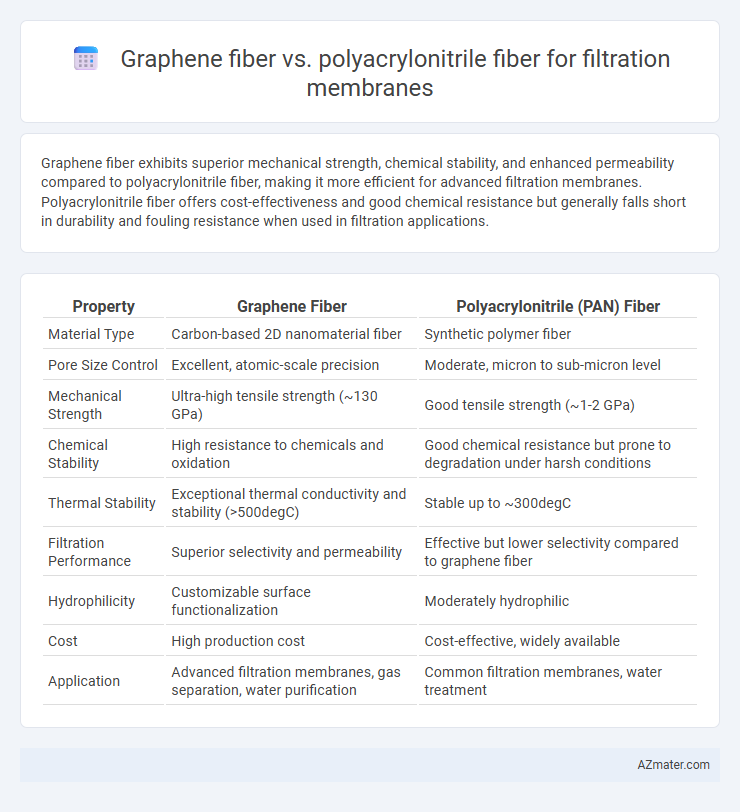Graphene fiber exhibits superior mechanical strength, chemical stability, and enhanced permeability compared to polyacrylonitrile fiber, making it more efficient for advanced filtration membranes. Polyacrylonitrile fiber offers cost-effectiveness and good chemical resistance but generally falls short in durability and fouling resistance when used in filtration applications.
Table of Comparison
| Property | Graphene Fiber | Polyacrylonitrile (PAN) Fiber |
|---|---|---|
| Material Type | Carbon-based 2D nanomaterial fiber | Synthetic polymer fiber |
| Pore Size Control | Excellent, atomic-scale precision | Moderate, micron to sub-micron level |
| Mechanical Strength | Ultra-high tensile strength (~130 GPa) | Good tensile strength (~1-2 GPa) |
| Chemical Stability | High resistance to chemicals and oxidation | Good chemical resistance but prone to degradation under harsh conditions |
| Thermal Stability | Exceptional thermal conductivity and stability (>500degC) | Stable up to ~300degC |
| Filtration Performance | Superior selectivity and permeability | Effective but lower selectivity compared to graphene fiber |
| Hydrophilicity | Customizable surface functionalization | Moderately hydrophilic |
| Cost | High production cost | Cost-effective, widely available |
| Application | Advanced filtration membranes, gas separation, water purification | Common filtration membranes, water treatment |
Introduction to Filtration Membranes
Filtration membranes rely on material properties like porosity, mechanical strength, and chemical stability, where graphene fiber offers exceptional tensile strength and high surface area compared to polyacrylonitrile (PAN) fiber. PAN fiber remains widely used due to its chemical resistance, ease of processing, and cost-effectiveness, but graphene fiber membranes exhibit enhanced permeability and selectivity for advanced filtration applications. Recent studies highlight graphene fiber's superior antifouling capabilities and thermal stability, making it a promising alternative for next-generation membrane technologies.
Overview of Graphene Fiber
Graphene fiber exhibits exceptional mechanical strength, electrical conductivity, and chemical stability, making it an advanced material for filtration membranes. Its porous structure and high surface area enable efficient contaminant adsorption and improved permeability compared to traditional polyacrylonitrile (PAN) fibers. The hydrophobic nature and tunable surface chemistry of graphene fiber contribute to superior antifouling properties and enhanced separation performance in water and air filtration applications.
Overview of Polyacrylonitrile (PAN) Fiber
Polyacrylonitrile (PAN) fiber is widely used in filtration membranes due to its excellent chemical resistance, thermal stability, and mechanical strength. PAN fibers exhibit a high surface area and porosity, enhancing their efficiency in capturing fine particles and contaminants in water and air filtration applications. Compared to graphene fibers, PAN fibers are more cost-effective and easier to produce at scale, making them a preferred choice for commercial membrane manufacturing.
Fabrication Methods of Graphene and PAN Fibers
Graphene fibers for filtration membranes are typically fabricated using chemical vapor deposition (CVD) or solution spinning methods, resulting in high-strength, conductive membranes with tunable porosity. Polyacrylonitrile (PAN) fibers are primarily produced through wet spinning or electrospinning techniques, creating porous structures suited for ultrafiltration and microfiltration applications. The fabrication of graphene fibers emphasizes atomic-scale control for enhanced adsorption capabilities, while PAN fiber manufacturing focuses on scalable methods to achieve uniform pore size distribution.
Structural Properties Comparison
Graphene fiber exhibits superior structural properties compared to polyacrylonitrile (PAN) fiber for filtration membranes, including higher tensile strength, enhanced flexibility, and exceptional chemical stability due to its two-dimensional carbon lattice. PAN fibers, while widely used for their porosity and ease of functionalization, generally have lower mechanical durability and are more susceptible to chemical degradation under harsh filtration conditions. The atomic-scale thickness and high surface area of graphene fibers enable greater filtration efficiency and fouling resistance compared to the relatively bulky and less conductive PAN fibers.
Filtration Performance and Efficiency
Graphene fiber membranes exhibit superior filtration performance compared to polyacrylonitrile (PAN) fibers due to their higher surface area, excellent chemical stability, and enhanced mechanical strength, enabling effective removal of contaminants at the nanoscale. Graphene's unique two-dimensional structure facilitates faster water flux and higher rejection rates of pollutants, including heavy metals and organic compounds. PAN fibers, while widely used for filtration membranes, often demonstrate lower permeability and fouling resistance, resulting in reduced filtration efficiency and lifespan in harsh environments.
Mechanical Strength and Durability
Graphene fiber exhibits superior mechanical strength compared to polyacrylonitrile (PAN) fiber, offering higher tensile strength and elasticity essential for filtration membranes subjected to high pressure and wear. The exceptional durability of graphene fibers results from their robust carbon-carbon bonds and resistance to chemical degradation, ensuring longer operational life in harsh filtration environments. In contrast, PAN fibers, while widely used, tend to have lower mechanical resilience and are more prone to degradation over time, impacting membrane performance and replacement frequency.
Chemical and Thermal Stability
Graphene fibers exhibit superior chemical resistance and thermal stability compared to polyacrylonitrile (PAN) fibers, making them ideal for harsh filtration environments. Graphene's carbon-based structure withstands temperatures up to 500degC without degradation, whereas PAN fibers typically degrade above 300degC. The exceptional oxidative stability and resistance to solvents in graphene fibers enhance membrane longevity and performance under aggressive chemical conditions.
Cost and Scalability Considerations
Graphene fiber membranes typically exhibit higher production costs and complex fabrication processes compared to polyacrylonitrile (PAN) fiber membranes, which benefit from established large-scale manufacturing techniques. The scalability of graphene fiber is currently limited by material synthesis challenges and expensive raw materials, while PAN fibers are widely produced with well-developed industrial infrastructures enabling cost-efficient mass production. Considering filtration membrane applications, PAN fibers remain more economically viable and scalable, although ongoing research in graphene fiber technology aims to reduce costs and improve commercial feasibility.
Future Prospects and Applications
Graphene fiber offers superior mechanical strength, electrical conductivity, and chemical stability compared to polyacrylonitrile (PAN) fiber, making it a promising material for next-generation filtration membranes. Its nanoscale structure enhances filtration efficiency and selectivity, particularly in water purification, gas separation, and chemical filtration applications. Future prospects include integration in smart membranes with self-cleaning and sensing capabilities, leveraging graphene's unique properties to address environmental challenges and improve membrane longevity.

Infographic: Graphene fiber vs Polyacrylonitrile fiber for Filtration membrane
 azmater.com
azmater.com